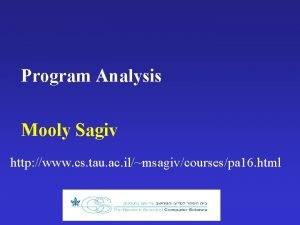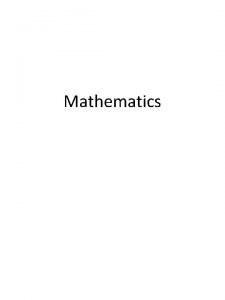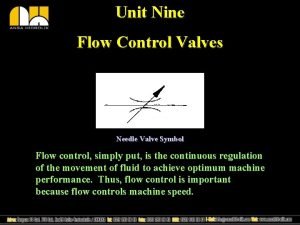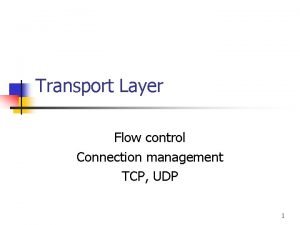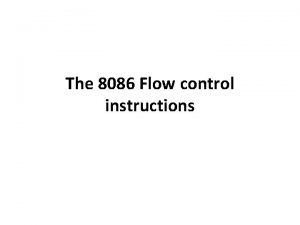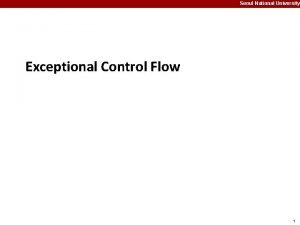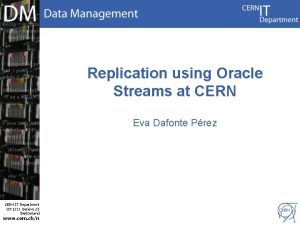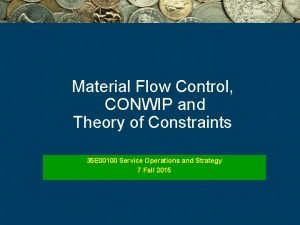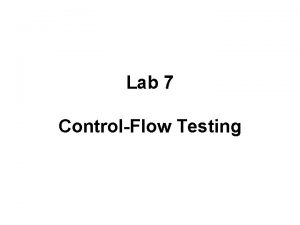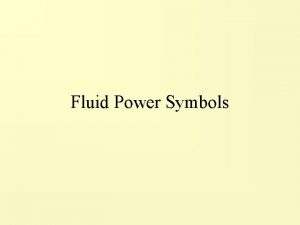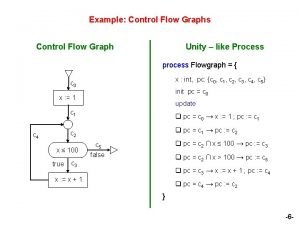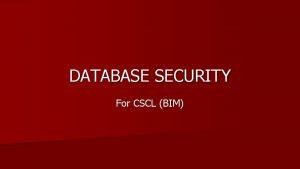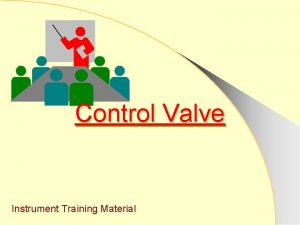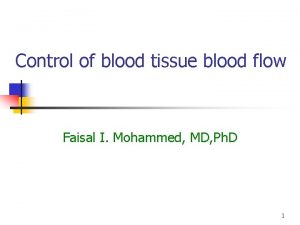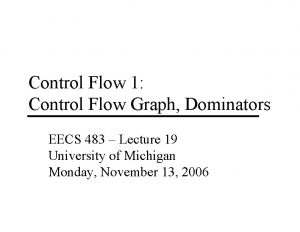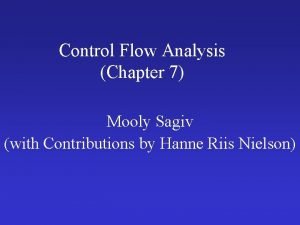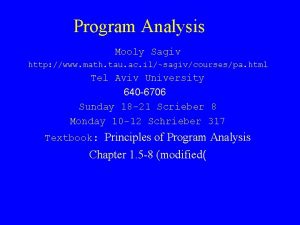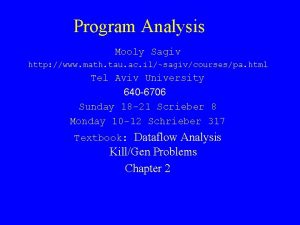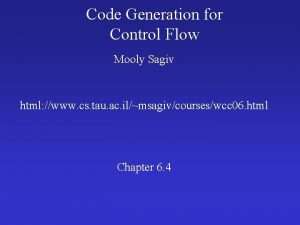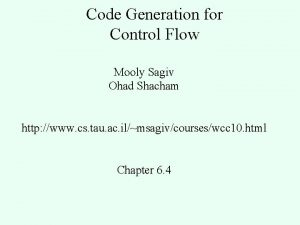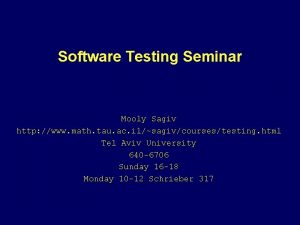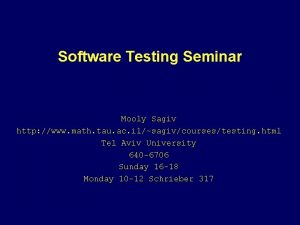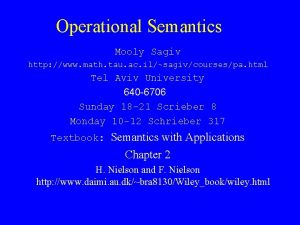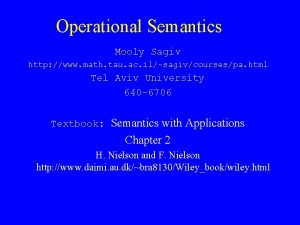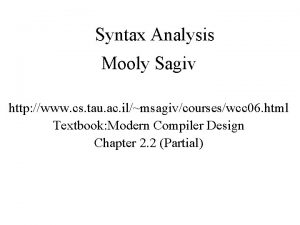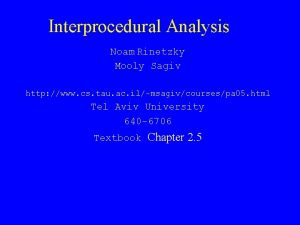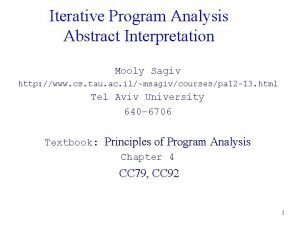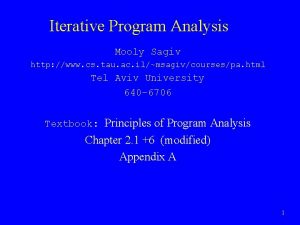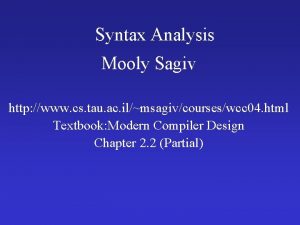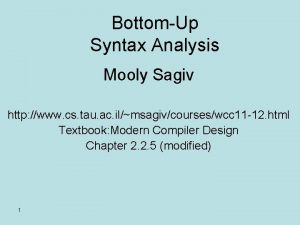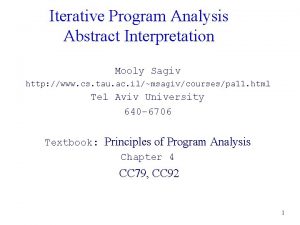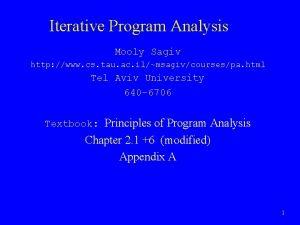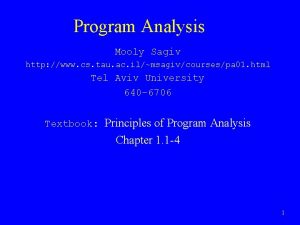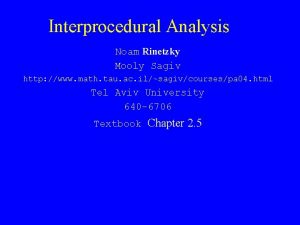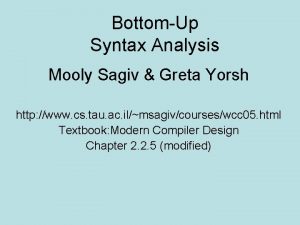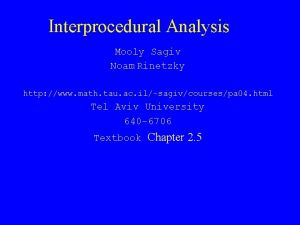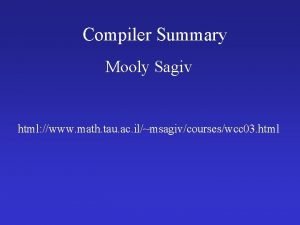Control Flow Analysis Mooly Sagiv http www math















![Syntax Directed 0 -CFA (Simple Expressions( ]const] (C, ) cl ]var] (C, ) xl Syntax Directed 0 -CFA (Simple Expressions( ]const] (C, ) cl ]var] (C, ) xl](https://slidetodoc.com/presentation_image_h2/d826f29a9ae388384d7d400401ebd3d9/image-16.jpg)
![Syntax Directed 0 -CFA Function Abstraction ]fn] (C, ) (fn x e)l if: )C, Syntax Directed 0 -CFA Function Abstraction ]fn] (C, ) (fn x e)l if: )C,](https://slidetodoc.com/presentation_image_h2/d826f29a9ae388384d7d400401ebd3d9/image-17.jpg)
![Syntax Directed 0 -CFA Function Application ]app] (C, ) (t 1 l 1 t Syntax Directed 0 -CFA Function Application ]app] (C, ) (t 1 l 1 t](https://slidetodoc.com/presentation_image_h2/d826f29a9ae388384d7d400401ebd3d9/image-18.jpg)
![Syntax Directed 0 -CFA Other Constructs ]if] (C, ) (if t 0 l 0 Syntax Directed 0 -CFA Other Constructs ]if] (C, ) (if t 0 l 0](https://slidetodoc.com/presentation_image_h2/d826f29a9ae388384d7d400401ebd3d9/image-19.jpg)

















- Slides: 36

Control Flow Analysis Mooly Sagiv http: //www. math. tau. ac. il/~sagiv/courses/pa. html Tel Aviv University 640 -6706 Sunday 18 -21 Scrieber 8 Monday 10 -12 Schrieber 317 Textbook Chapter 3 (Simplified+OO(

Goals u Understand the problem of Control Flow Analysis – in Functional Languages – In Object Oriented Languages – Function Pointers u Learn Constraint Based Program Analysis Technique – – General Usage for Control Flow Analysis Algorithms Systems u Similarities between Problems &Techniques

Outline u u u u u A Motivating Example (OO( The Control Flow Analysis Problem A Formal Specification Set Constraints Solving Constraints Adding Dataflow information Adding Context Information Back to the Motivating Example Conclusions

A Motivating Example class Vehicle Object { int position = 10; void move(x 1 : int } ( position = position + x 1{{; class Car extends Vehicle { int passengers; void await(v : Vehicle} ( if (v. position < position ( then v. move(position - v. position; ( else self. move(10{{ ; ( class Truck extends Vehicle } void move(x 2 : int} ( if (x 2 < 55) position = position + x 2{{ ; void main { Car c; Truck t; Vehicle v 1; new c ; new t ; v 1 : = c; c. passangers : = 2; c. move(60; ( v 1. move(70; ( c. await(t{; (

The Control Flow Analysis (CFA) Problem u Given a program in a functional programming language with higher order functions (functions can serve as parameters and return values( u Find out for each function invocation which functions may be applied u Obvious in C without function pointers u Difficult in C++, Java and ML u The Dynamic Dispatch Problem

An ML Example let f = fn x => x 1; g = fn y => y + 2; h = fn z => z + 3; in (f g) + (f h(

An ML Example let f = fn x => /* {g, h} */ x 1; g = fn y => y + 2; h = fn z => z + 3; in (f g) + (f h(

u Notations – – – The Language FUN e Exp // expressions (or labeled terms( t Term // terms (or unlabeled terms( f, x Var // variables c Const // Constants op Op // Binary operators l Lab // Labels u Abstract Syntax – e : : = tl – t : : = c | x | fn x e // function definition | fun f x e // recursive function definition | e 1 e 2 // function applications | if e 0 then e 1 else e 2 | let x = e 1 in e 2 | e 1 op e 2

A Simple Example ))fn x x 1)2 (fn y y 3)4)5

An Example which Loops )let g = fun f x (f 1 (fn y y 2)3)4 )5 )g 6 (fn z z 7)8)9 )10

The 0 -CFA Problem u Compute for every program a pair (C, ) where: – C is the abstract cache associating abstract values with labeled program points – is the abstract environment associating abstract values with variables u Formally – – v Val = P(Term) // Abstract values Env = Var Val // Abstract environment C Cache - Lab Val // Abstract Cache For function application (t 1 l 1 t 2 l 2)l C(l 1) determine the function that can be applied u These maps are finite for a given program u No context is considered for parameters

Possible Solutions for ((fn x x 1)2 (fn y y 3)4)5

)let g = fun f x (f 1 (fn y y 2)3)4 )5 )g 6 (fn z z 7)8)9 )10 Shorthand sf fun f x (f 1 (fn y y 2)3)4 idy fn y y 2 idz fn z z 7 C(1) = {sf} C(2) = {} C(3) = {idy{ C(4) = {} C(5) = {sf} C(6) = {sf{ C(7) = {} C(8) = {idy} C(9{} = ( C(10) = {} (x) = {idy , idy } (z {} = ( (y{} = (

Relationship to Dataflow Analysis u Expressions are side effect free – no entry/exit u. A single environment u Represents information at different points via maps u A single value for all occurrences of a variable u Function applications act similar to assignments – “Definition” - Function abstraction is created – “Use” - Function is applied

A Formal Specification of 0 -CFA Boolean function define when a solution is acceptable u )C, ) e means that (C, ) is acceptable for the expression e u Define by structural induction on e u Every function is analyzed once u Every acceptable solution is sound (conservative( u Many acceptable solutions u Generate a set of constraints u Obtain the least acceptable solution by solving the constraints u. A
![Syntax Directed 0 CFA Simple Expressions const C cl var C xl Syntax Directed 0 -CFA (Simple Expressions( ]const] (C, ) cl ]var] (C, ) xl](https://slidetodoc.com/presentation_image_h2/d826f29a9ae388384d7d400401ebd3d9/image-16.jpg)
Syntax Directed 0 -CFA (Simple Expressions( ]const] (C, ) cl ]var] (C, ) xl always if (x) C (l(
![Syntax Directed 0 CFA Function Abstraction fn C fn x el if C Syntax Directed 0 -CFA Function Abstraction ]fn] (C, ) (fn x e)l if: )C,](https://slidetodoc.com/presentation_image_h2/d826f29a9ae388384d7d400401ebd3d9/image-17.jpg)
Syntax Directed 0 -CFA Function Abstraction ]fn] (C, ) (fn x e)l if: )C, ) e fn x e C(l( ] fun] (C, ) (fun f x e)l if: ) C, ) e fun x e C(l( fun x e (f(
![Syntax Directed 0 CFA Function Application app C t 1 l 1 t Syntax Directed 0 -CFA Function Application ]app] (C, ) (t 1 l 1 t](https://slidetodoc.com/presentation_image_h2/d826f29a9ae388384d7d400401ebd3d9/image-18.jpg)
Syntax Directed 0 -CFA Function Application ]app] (C, ) (t 1 l 1 t 2 l 2)l if: )C, ) t 1 l 1 )C, ) t 2 l 2 for all fn x t 0 l 0 C(l : ( C (l 2) (x) C(l 0) C(l( for all fun x t 0 l 0 C(l : ( C (l 2) (x) C(l 0) C(l(
![Syntax Directed 0 CFA Other Constructs if C if t 0 l 0 Syntax Directed 0 -CFA Other Constructs ]if] (C, ) (if t 0 l 0](https://slidetodoc.com/presentation_image_h2/d826f29a9ae388384d7d400401ebd3d9/image-19.jpg)
Syntax Directed 0 -CFA Other Constructs ]if] (C, ) (if t 0 l 0 then t 1 l 1 else t 2 l 2)l )C, ) t 0 l 0 )C, ) t 1 l 1 )C, ) t 2 l 2 C(l 1) C(l( C(l 2) C(l( ]let] (C, ) (let x = t 1 l 1 in t 2 l 2)l if: )C, ) t 1 l 1 )C, ) t 2 l 2 C(l 1) (x ( C(l 2) C(l( ]op] (C, ) (t 1 l 1 op t 2 l 2)l if: ) C, ) t 1 l 1 )C, ) t 2 l 2 if:

Possible Solutions for ((fn x x 1)2 (fn y y 3)4)5

Set Constraints u. A set of rules of the form: – lhs rhs – }t} rhs’ lhs rhs (conditional constraint( – lhs, rhs’ are » terms » C(l( » (x( u The least solution (C, ) can be found iterativelly – start with empty sets – add terms when needed u Efficient cubic graph based solution

Syntax Directed Constraint Generation (Part I( C* cl {} = C* xl = { (x) C (l{( C* (fn x e)l = C* e { {fn x e} C(l{( C* (fun x e)l = C* e { {fun x e} C(l)} {{fun x e} ( f{( C* (t 1 l 1 t 2 l 2)l = C* t 1 l 1 C* t 2 l 2 }}t} C(l) C (l 2) (x) | t=fn x t 0 l 0 Term* } }} t} C(l) C (l 0) C (l) | t=fn x t 0 l 0 Term* } {{t} C(l) C (l 2) (x) | t=fun x t 0 l 0 Term* } }}t} C(l) C (l 0) C (l) | t=fun x t 0 l 0 Term { *

Syntax Directed Constraint Generation (Part II( C* (if t 0 l 0 then t 1 l 1 else t 2 l 2)l = C* t 0 l 0 C* t 1 l 1 C* t 2 l 2 }C(l 1) C (l)} }C(l 2) C (l{( C* (let x = t 1 l 1 in t 2 l 2)l = C* t 1 l 1 C* t 2 l 2 }C(l 1) (x)} }C(l 2) C(l{( C* (t 1 l 1 op t 2 l 2)l = C* t 1 l 1 C* t 2 l 2

Set Constraints for ((fn x x 1)2 (fn y y 3)4)5

Iterative Solution to the Set Constraints for ((fn x x 1)2 (fn y y 3)4)5

Adding Data Flow Information u Dataflow u Example values can affect control flow analysis (let f = (fn x (if (x 1 > 02)3 then (fn y y 4)5 else (fn z 56)7 )8 )9 in ((f 10 311)12 013)14)15

Adding Data Flow Information u Add a finite set of “abstract” values per program Data u Update Val = P(Term Data ( – Env = Var Val // Abstract environment – C Cache - Lab Val // Abstract Cache u Generate extra constraints for data u Obtained a more precise solution u A special of case of product domain (4. 4( u The combination of two analyses may be more precise than both

Adding Dataflow Information (Sign Analysis( u Sign analysis u Add a finite set of “abstract” values per program Data = {P, N, TT, FF{ u Update Val = P(Term Data ( u dc is the abstract value that represents a constant c d 3 = {p{ – d-7= {n{ – dtrue= {tt{ – dfalse= {ff{ – u Every operator is conservatively interpreted

Syntax Directed Constraint Generation (Part I( C* cl = dc C (l{( C* xl = { (x) C (l{( C* (fn x e)l = C* e { {fn x e} C(l{( C* (fun x e)l = C* e { {fun x e} C(l)} {{fun x e} ( f{( C* (t 1 l 1 t 2 l 2)l = C* t 1 l 1 C* t 2 l 2 }}t} C(l) C (l 2) (x) | t=fn x t 0 l 0 Term* } }} t} C(l) C (l 0) C (l) | t=fn x t 0 l 0 Term* } {{t} C(l) C (l 2) (x) | t=fun x t 0 l 0 Term* } }}t} C(l) C (l 0) C (l) | t=fun x t 0 l 0 Term { *

Syntax Directed Constraint Generation (Part II( C* (if t 0 l 0 then t 1 l 1 else t 2 l 2)l = C* t 0 l 0 C* t 1 l 1 C* t 2 l 2 }dt C (l 0) C(l 1) C (l)} }df C (l 0) C(l 2) C (l{( C* (let x = t 1 l 1 in t 2 l 2)l = C* t 1 l 1 C* t 2 l 2 }C(l 1) (x)} }C(l 2) C(l{( C* (t 1 l 1 op t 2 l 2)l = C* t 1 l 1 C* t 2 l 2 {C(l 1) op C(l 2) C(l{(

Adding Context Information u The analysis does not distinguish between different occurrences of a variable (Monovariant analysis( u Example (let f = (fn x x 1) 2 in ((f 3 f 4)5 (fn y y 6) 7)8)9 u Source to source can help (but may lead to code explosion( u Example rewritten let f 1 = fn x 1 in let f 2 = fn x 2 in (f 1 f 2) (fn y y(

Simplified K-CFA u Records the last k dynamic calls (for some fixed k( u Similar to the call string approach u Remember the context in which expression is evaluated u Val is now P(Term) Contexts – Env = Var Contexts Val – C Cache - Lab Contexts Val

1 -CFA f = (fn x x 1) 2 in ((f 3 f 4)5 (fn y y 6) 7)8)9 u Contexts u )let – - [] The empty context – [5]The application at label 5 – [8]The application at label 8 u Polyvariant Control Flow C(1, [5]) = (x, 5)= C(2, []) = C(3, []) = (f, []) = ({(fn x x 1)}, [] ) C(1, [8]) = (x, 8)= C(7, []) = C(8, []) = C(9, []) = ({(fn y y 6 ( [] , {(

The Motivating Example class Vehicle Object { int position = 10; void move(x 1 : int } ( position = position + x 1{{; class Car extends Vehicle { int passengers; void await(v : Vehicle} ( if (v. position < position ( then v. move(position - v. position; ( else self. move(10{{ ; ( class Truck extends Vehicle } void move(x 2 : int} ( if (x 2 < 55) position = position + x 2{{ ; void main { Car c; Truck t; Vehicle v 1; new c ; new t ; v 1 : = c; c. passangers : = 2; c. move(60; ( v 1. move(70; ( c. await(t{; (

Missing Material u Efficient u Cubic Solution to Set Constraints www. cs. berkeley. edu/Research/Aiken/bane. html Experimental results for OO www. cs. washington. edu/research/projects/cecil u Operational Semantics for FUN (3. 2. 1( u Defining acceptability without structural induction – More precise treatment of termination (3. 2. 2( – Needs Co-Induction (greatest fixed point( u Using general lattices as Dataflow values instead of powersets (3. 5. 2( u Lower-bounds – Decidability of JOP – Polynomiality

Conclusions u Set constraints are quite useful – A Uniform syntax – Can even deal with pointers u But semantic foundation is still based on abstract interpretation u Techniques used in functional and imperative (OO) programming are similar u Control and data flow analysis are related
 Mooly sagiv
Mooly sagiv Data flow vs control flow
Data flow vs control flow Control flow and data flow computers
Control flow and data flow computers Control flow vs transaction flow
Control flow vs transaction flow Stock control e flow control
Stock control e flow control Control flow error
Control flow error Http //mbs.meb.gov.tr/ http //www.alantercihleri.com
Http //mbs.meb.gov.tr/ http //www.alantercihleri.com Siat.ung.ac.id
Siat.ung.ac.id · meaning in math
· meaning in math Math game math hit the button
Math game math hit the button Absorptive atelectasis
Absorptive atelectasis Simple mask flow rate
Simple mask flow rate High flow versus low flow oxygen
High flow versus low flow oxygen Lumina flow
Lumina flow Internal vs external flow
Internal vs external flow Ecological succession
Ecological succession Oikos meaning
Oikos meaning Structure chart in software engineering
Structure chart in software engineering Transform flow and transaction flow
Transform flow and transaction flow Definition of irrotational flow
Definition of irrotational flow External flow vs internal flow
External flow vs internal flow Cheese making process diagram
Cheese making process diagram Temperature compensated flow control valve symbol
Temperature compensated flow control valve symbol Udp flow control
Udp flow control Cmp in microprocessor
Cmp in microprocessor Exceptional control flow
Exceptional control flow Repl capture/apply: flow control
Repl capture/apply: flow control Material flow control
Material flow control Control flow graph for bubble sort
Control flow graph for bubble sort Unidirectional variable displacement pump symbol
Unidirectional variable displacement pump symbol Flow graph example
Flow graph example Define database security
Define database security Control valve flow characteristics
Control valve flow characteristics Lactic acid vasodilation
Lactic acid vasodilation Control flow guard
Control flow guard Ipdom
Ipdom Dd path graph is called
Dd path graph is called
